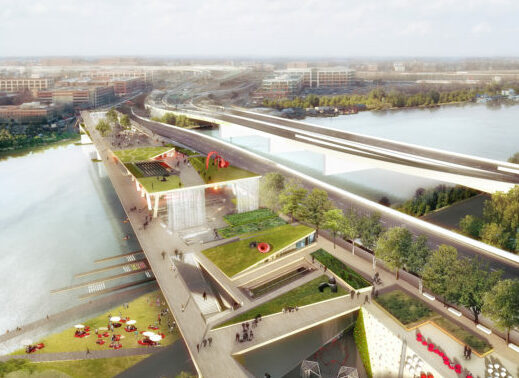
Washington, DC’s 11th Street Bridge Park/Photo: OMA + OLIN Anacostia Crossing
There’s a movement afoot that aims to turn old infrastructure into public parks, breathing new life into spaces that have long since been forgotten. Of these, the transformation of an old rail line into a garden on Manhattan’s West Side (the High Line) is the best known. Now comes Washington, DC’s own variation, the 11th Street Bridge Park. Soon, the city’s first elevated park will be perched high atop the Anacostia River.
BRIDGING TWO COMMUNITIES
Slated to be built atop the piers of the old 11th street bridge, the ambitious project will serve as a link between Capitol Hill and Anacostia; two communities that, until now, have rarely crossed paths. The new venue will offer residents a space for recreation, environmental education and public arts. Most importantly, it will provide a one-of-a-kind urban garden designed to attract residents from all parts of the city.
Elevation view/Photo: OMA + OLIN Anacostia Crossing
GOING WITH THE FLOW
Project Director Scott Kratz initially came to DC to become the National Building Museum’s Vice President for Education. However, soon after arriving, he met with Harriet Tregoning, DC’s then director of planning. During her tenure, Tregoning had played a major role in reshaping many of DC’s neighborhoods. Kratz couldn’t know at the time that a simple question would lead to a life-changing proposition.
Specifically, Kratz asked Tregoning what was happening with the 11th street bridges, in particular the one that appeared to be abandoned. It was Tregoning who proposed turning the bridge into a park. Further, she suggested the park not only be recreational, but also ‘stitch’ disparate communities back together. For Katz, the idea was intriguing. Soon after, he became director of the project.

11th Street Bridge Park Project/Photo via Scott Kratz
WHY THE ANACOSTIA?
The Anacostia River runs along the southern border of Washington, DC. In the 1960s, the old 11th Street Bridge was constructed to link the communities on either side. However, while the bridge physically spanned the space, the communities remained divided. As a result, there were huge social and economic disparities between the two.
In time, the old bridge outlived its function and was replaced by three brand new bridges.

11th Street Bridge Project/Photo via Scott Kratz
COMMUNITY INPUT DROVE THE DESIGN
Partly due to this imbalance, Kratz and his team decided to adopt an innovative approach to their park project. Long before any architect or landscape designer was hired, they went into the community to ask residents for permission.
In the first two years, Kratz estimates that he and his team attended over 200 community meetings. These communities in turn helped drive the programming for the park. They inspired such ideas as an outdoor amphitheater, kayak/canoe launches, intergenerational play space and public art. Later, these suggestions and more were incorporated into the final design.

Exterior view/Photo: OLIN
In 2014, a competition was launched, attracting 41 architectural, landscape and structural engineering firms from around the world. The design team Office for Metropolitan Architecture (OMA) and the landscape architecture firm OLIN (known for the National Sculpture Garden, among other large DC projects) were selected.

Site plan/Photo: OMA + OLIN
Said OMA designer Jason Long (of the winning design),
We wanted the bridge to have a civic importance. It holds its own against very monumental elements within D.C. – but at the same time it’s very approachable.
And the New York Times predicts the park will become a recreation area of national significance.
A FUTURE MONUMENT
Bound by the Washington Navy Yard on one side and the National Park Service’s Anacostia Park on the other, the Bridge Park will be adjacent to the new 11th Street local bridge where it will link to a network of river walk trails. Hopes are that it will become not only a regional destination but also an iconic symbol that will take its place among the famous monuments of the city.
The final plans include a series of native plantings schemes, rain gardens, water features, an Environmental Education Center (with floating docks for canoes and kayaks) and space for public art. In addition, two large trusses will enclose a 280–person amphitheater.

Section of Bridge Park/Photo: OMA
Above all, water will play a critical role in the project. A main waterfall, located outside the Environmental Education Center, will feature projections of historical images, (such as Frederick Douglas who often took walks there) while various smaller waterfalls will aid in re-oxygenating the river. Similarly, the project designers hope that in capturing storm water and creating moving features they can help bring back native mollusks to restore the urban watershed.

Waterfall featuring iconic images/Photo: OMA
The Bridge Park will be high enough to see over the Navy Yard and even afford panoramic views of the Capitol and Washington Monument. Atop the structure, a Hammock Grove will offer a place for visitors to linger while taking in the amazing views of the city.

Observation platform/Photo: OMA and Luxigon
The 11th Street Bridge Park is a project of Building Bridges Across the River (BBAR) at THE ARC. THEARC is home to ten of Washington, DC’s best nonprofit agencies who work collaboratively under BBAR’s leadership to provide cultural arts, social services, health care, recreation and educational programs.
Pre-construction of the park began in December. Kratz estimates 1 ½ years for pre-construction and 1 ½ years for construction. Hopes are for the 11th Street Bridge Park to open sometime in 2019.
For more information email scott@bridgepark.org or visit www.bridgepark.org.


